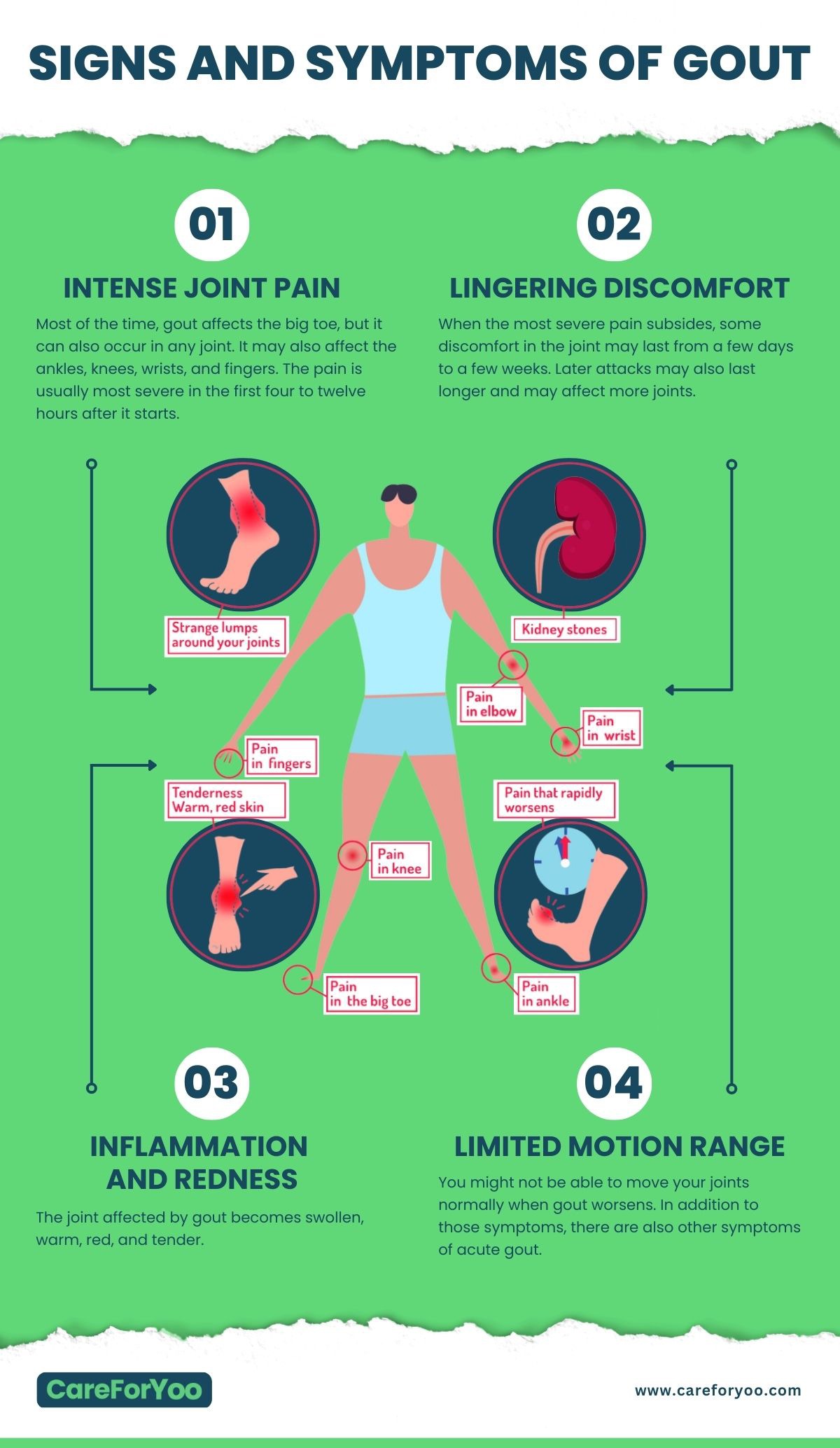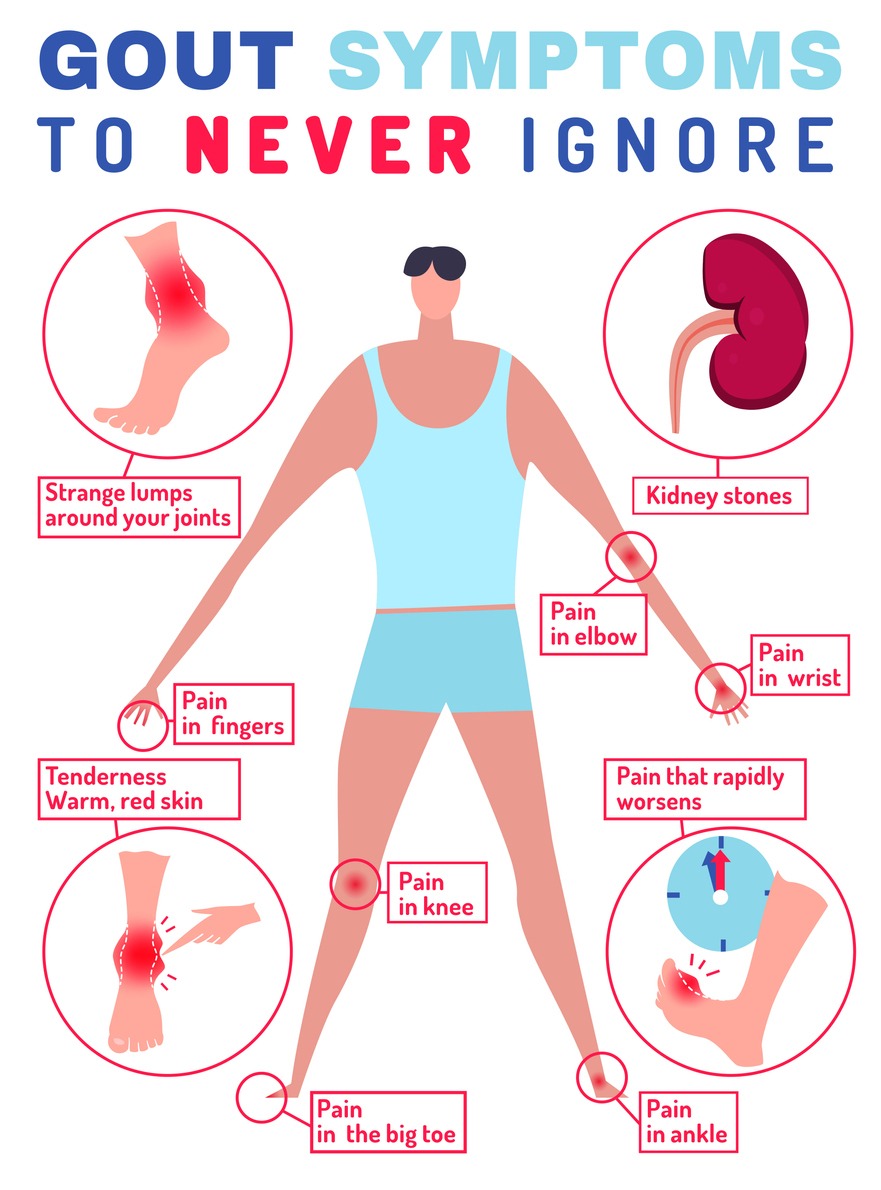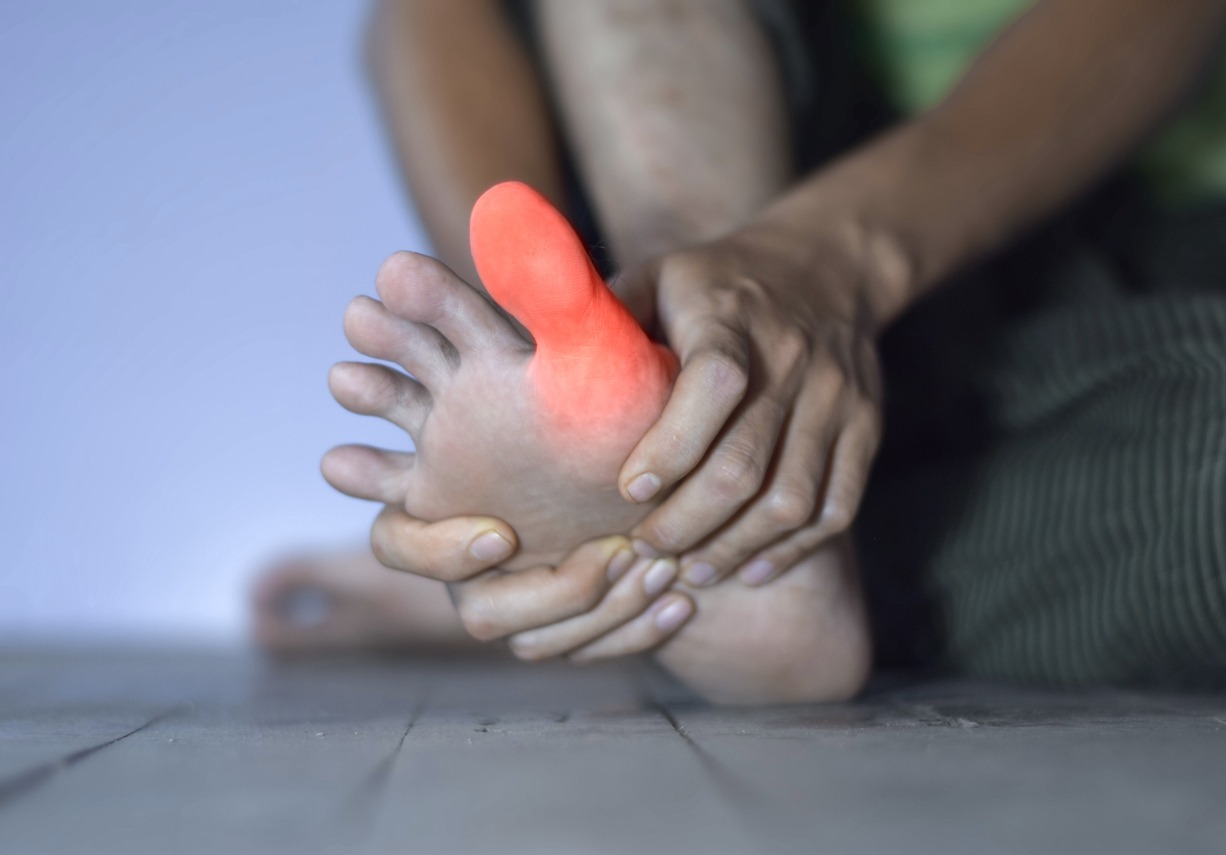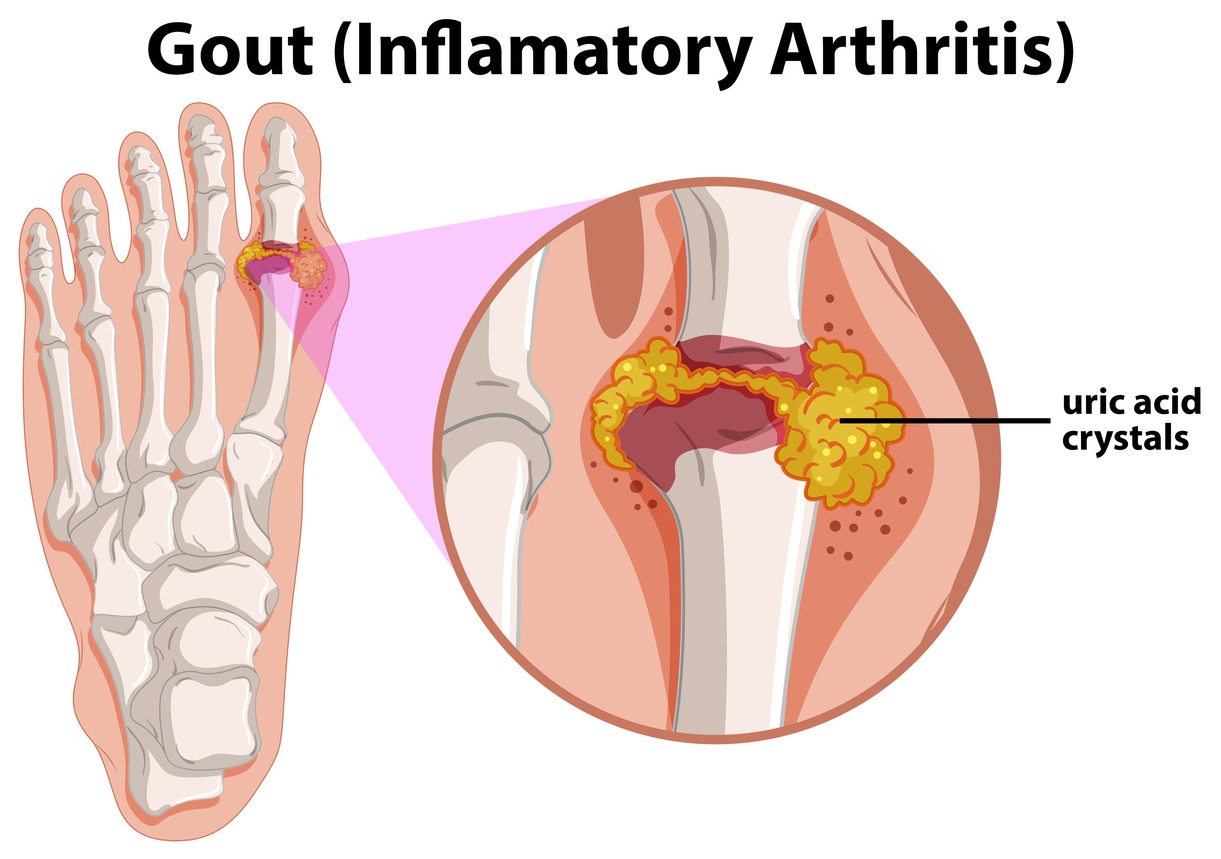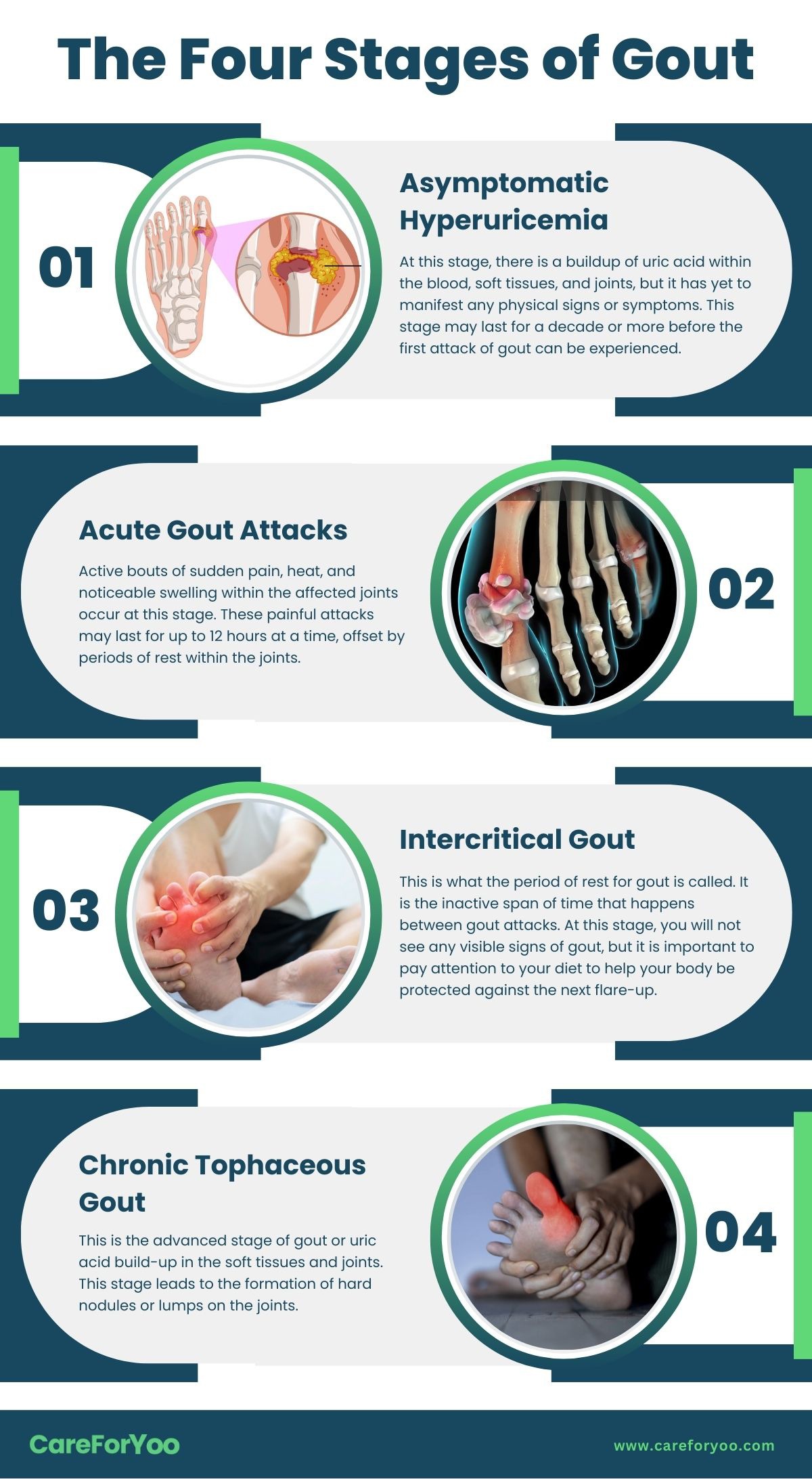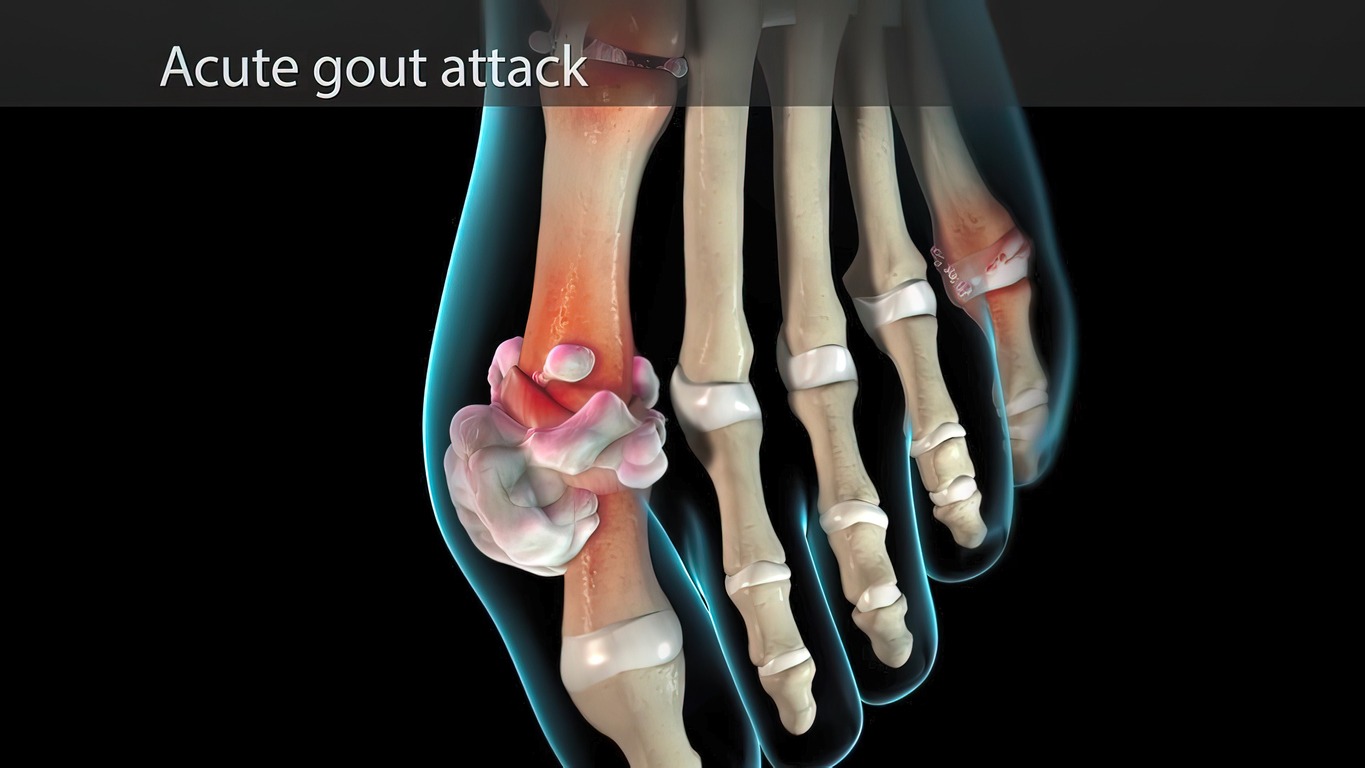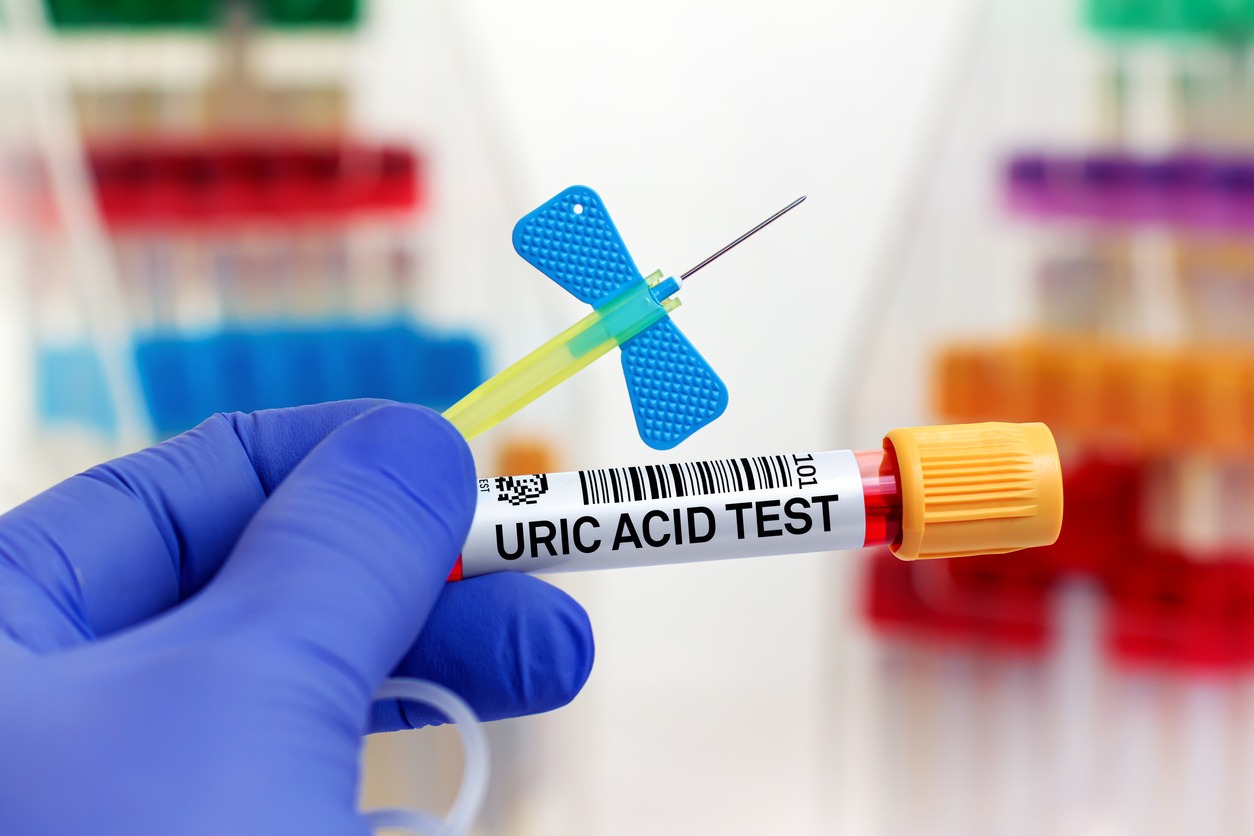Disclaimer: This article is for informational and educational purposes only and does not substitute professional medical advice. It is important to always consult a medical professional for any health issues.
Gout is a common and multifaceted type of arthritis that can affect anyone. It is a general term for different conditions caused by a buildup of uric acid, and it usually affects the feet. It is characterized by sudden, severe attacks of pain, swelling, redness, and tenderness in one or more joints, particularly in the big toe. A gout attack can happen suddenly, and it usually wakes people up in the middle of the night with the sensation that their big toe is on fire. The affected joint is burning, swollen, and very tender, and even the weight of the bedsheet on it may seem unbearable. [1]
The big toe is where gout attacks most frequently happen, although the ailment can also affect nearby joints in the foot, ankle, and knee. The symptoms of gout may come and go, but there are also different ways to manage the symptoms and prevent flares. [1] If you often experience gout attacks and are looking for ways to treat the condition, we are here to help you. In this post, we are giving you a complete guide on the treatment for gout in the feet.
Signs and Symptoms of Gout
Gout sufferers typically go through episodes or bouts of symptoms, followed by remissions. Most of the time, the attacks last 3 to 10 days. Some people even go months or years without a gout attack after having one. There are also other people who have more frequent gout attacks over time.
The most dramatic, common, and noticeable symptom of gout is pain. [2] For a lot of people, the first flare-up occurs in the big toe. Below are the different signs and symptoms of gout:
Intense Joint Pain
Most of the time, gout affects the big toe, but it can also occur in any joint. It may also affect the ankles, knees, wrists, and fingers. The pain is usually most severe in the first four to twelve hours after it starts. [1]
Lingering Discomfort
When the most severe pain subsides, some discomfort in the joint may last from a few days to a few weeks. Later attacks may also last longer and may affect more joints. [1]
Inflammation and Redness
The joint affected by gout becomes swollen, warm, red, and tender. [1]
Limited Motion Range
You might not be able to move your joints normally when gout worsens. [1]
In addition to those symptoms, there are also other symptoms of acute gout. One of those is sudden crushing or throbbing pain in one or a few joints that may last for a few days. There are times when acute gout arthritis attack has a sudden onset at nighttime. [2]
Some people may also experience chronic gout. Compared with acute gout pain, chronic gout pain is more of a persistent ache or soreness. It is a kind of pain that frequently manifests as a more persistent, dull aching or soreness in the joints. [2]
Causes of Gout in the Feet
Gout mostly occurs in only one joint at a time, often in the big toe. There are times when lesser toe joints are also affected, which include the ankle and the knee. Gout is caused by a condition referred to as hyperuricemia, where there is too much uric acid in the body. [3]
The body produces uric acid to break down purines, which are found in the body and the foods that we eat. When too much uric acid is produced, uric acid crystals called monosodium urate can build up in joints, fluids, and tissues in the body. But hyperuricemia does not always cause gout, and it does not need to be treated. [3]
There are various things that may increase your chances of gout. The following makes it more possible that you will develop hyperuricemia, which causes gout: [3]
- Being obese
- Being make
- Having certain health conditions like congestive heart failure, insulin resistance, hypertension, diabetes, metabolic syndrome, and poor kidney function
- Taking certain medications like diuretics or water pills.
- Drinking alcohol
- Eating and drinking foods that are high in fructose.
- Having a diet high in purines, such as red meat, organ meat, anchovies, sardines, mussels, tuna, scallops, and trout.
Risk Factors of Gout
People are more likely to develop gout if they have high levels of uric acid in the body. Some of the elements listed below may cause your body’s level of uric acid to rise:
Diet
Eating a diet that is rich in red meat and shellfish, as well as drinking beverages that are sweetened with fructose, may increase levels of uric acid. This, in turn, increase your risk of gout. Alcoholic drinks, particularly beer, also increase the risk of gout.
Weight
People who are overweight tend to produce more uric acid. With this, their kidneys have a more difficult time eliminating uric acid. [1]
Medical Conditions
There are also certain health conditions that may increase your risk of gout. These may include untreated high blood pressure, diabetes, obesity, metabolic syndrome, kidney diseases, and heart diseases.
Certain Medications
There are medications that may increase uric acid, such as low-dose aspirin and medicines used to control hypertension. These include thiazide diuretics, angiotensin-converting enzyme inhibitors, and beta blockers. This also includes the use of anti-rejection drugs, which are mostly given to people who have undergone organ transplants. [1]
Familial Gout History
You have a greater risk of getting gout if other family members have the condition.
Age and Sex
Gout usually occurs in men, mainly due to the fact that women have lower uric acid levels. But after menopause, the uric acid levels of women approach those of men. Aside from that, men are more likely to develop gout earlier, between the ages of 30 and 50. Women, on the other hand, develop signs and symptoms after menopause. [1]
Recent Surgery or Trauma
Undergoing surgery or experiencing trauma may also trigger a gout attack. For some people, receiving a vaccination may trigger a gout flare. [1]
Gout Complications
People who are suffering from gout may also develop more severe conditions. Below are some of them:
Recurrent Gout
There are some people who may never experience gout signs and symptoms again, while others may experience them several times each year. There are medications that may help prevent gout attacks in people who have recurrent gout. However, if the condition is left untreated, gout may cause erosion and destruction of a joint. [1]
Advanced Gout
Untreated gout may result in deposits of urate crystals forming under the skin as nodules known as tophi. This can develop in several areas, such as your feet or achilles tendons along the backs of the ankles. It is usually not painful but can be swollen and tender during gout attacks. [1]
Kidney Stones
Urate crystals may also collect in the urinary tracts of people who have gout. This may cause kidney stones. But there are available medications that may help reduce the risk of kidney stones. [1]
The Four Stages of Gout
There are various stages of gout that affect the feet. Each stage is essential to learn about in order to understand how to address the symptoms and the right treatment that would be appropriate. Below are the four stages of gout:
Asymptomatic Hyperuricemia
At this stage, there is a buildup of uric acid within the blood, soft tissues, and joints, but it has yet to manifest any physical signs or symptoms. This stage may last for a decade or more before the first attack of gout can be experienced. [4]
Acute Gout Attacks
Active bouts of sudden pain, heat, and noticeable swelling within the affected joints occur at this stage. These painful attacks may last for up to 12 hours at a time, offset by periods of rest within the joints. [4]
Intercritical Gout
This is what the period of rest for gout is called. It is the inactive span of time that happens between gout attacks. At this stage, you will not see any visible signs of gout, but it is important to pay attention to your diet to help your body be protected against the next flare-up. [4]
Chronic Tophaceous Gout
This is the advanced stage of gout or uric acid build-up in the soft tissues and joints. This stage leads to the formation of hard nodules or lumps on the joints. These deposits that develop under the skin are unsightly, uncomfortable protrusions and may lead to deformity of the joints. But with proper treatment, these nodules may disappear before any actual deformity happens. [4]
Different Treatments for Gout on the Feet
When you have been diagnosed with gout, doctors will aim to reduce your pain as soon as possible. If you are looking for ways how to treat gout or alleviate its symptoms, there are actually different options to choose from. While there are many different treatments and remedies that you may find online, it is still very important to visit a doctor to get the right treatment for gout. To give you more ideas, below are the different treatments for gout in the feet.
Prescribed Medications
To treat gout attacks or flare-ups, a variety of different medications are available. Below are some of them:
- Nonsteroidal Anti-Inflammatory Drugs (NSAIDs): These medications work by blocking prostaglandins, which promote pain and inflammation. Some of the common over-the-counter NSAIDs include naproxen, aspirin, and ibuprofen. Doctors may also prescribe this type of medicine, and the most common ones include ketoprofen, naproxen sodium, and celecoxib. Keep in mind that it is very important to talk to your doctor first before taking any of these medicines. [2]
- Colchicine: For those who can’t tolerate NSAIDs, doctors may also prescribe colchicine. However, this medication should be taken daily. It may also have side effects, such as abdominal cramps, diarrhea, vomiting, and nausea. [2]
- Corticosteroids: This type of gout medication may be taken orally or injected directly into the affected joint. Some of the most common corticosteroids used for gout include prednisone, prednisolone, and methylprednisolone. [2]
- Uric–Acid-Lowering Medicine: There are also medicines prescribed by doctors to lower uric acid levels. Some examples are losartan or allopurinol. These medications are taken daily and used long-term. Based on gout guidelines, it is recommended to take these with a three-to-six-month course of NSAIDs. [2]
Alternative and Complementary Therapies
In addition to taking medications, there are also lots of complementary and alternative medicine (CAM) approaches that can help manage gout. These are commonly focused on diet, weight loss, and exercise.
If your diet is high in naturally occurring compounds called purines, your risk of gout goes up. When purines break down in the body, this cause uric acid to develop. Mostly, people who have gout still need to take medicines even when following a diet for gout. But changing your diet can be a great way to manage gout and its symptoms. In fact, based on research by the Institute for Quality and Efficiency in Health Care, food changes alone can lower uric acid levels by up to 15%. [2]
- Gout Diet: The principles of a gout diet are almost the same as those of any healthy diet. You need to reduce calorie consumption, especially if you are overweight. Choose foods with unrefined carbohydrates, such as vegetables, fruits, and whole grains. You also need to limit your sugar intake and avoid eating organ meats like liver and foods rich in saturated fats. [2]
- Weight Loss: You are likely to have higher-than-normal uric acid levels if you are overweight. It is a primary risk factor for developing gout. Therefore, weight loss is a very important part of a gout diet and treatment. The risk of future gout attacks may be decreased, and uric acid levels may be lowered with weight loss. [2]
- Appropriate Exercise: There are many people with gout who avoid exercise as they fear it will make the inflamed joints worse. But there are special programs that may help people with all kinds of arthritis adapt to their exercise needs. You can reach out to personal trainers and coaches for the right type of exercise that will help in treating your gout. [2]
Pain Relief Creams for Gout
Gout attacks truly feel debilitating. But there are also products like pain relief creams that you can use, which are powerful enough to relieve pain, reduce inflammation, and increase mobility. Most of these creams are safe to use and can be bought over the counter. If you are experiencing gout flare-ups and looking for creams that may help alleviate the pain, below are some examples to help you choose:
- Wise Men Therapeutic Gout Balm: This is a powerful cream for gout that you can buy over the counter. It contains potent but all-natural ingredients that have been used for many years to treat common joint pains. Some of these ingredients include wintergreen essential oils, coconut oil, lemon oil, and geranium. It can provide effective and safe treatment for foot gout. You just need to apply it to the affected area. After that, you will begin to feel relief.
- Gout And You Pain Relief Cream: This cream can provide soothing pain relief for the feet for those who are experiencing gout attacks. It is made of natural ingredients, such as tea tree oil, ilex leaf extract, vitamin E, and more. It is a potent cream that is fast-absorbing to provide fast relief. You just need to apply the cream along the affected area and wait for a few minutes for it to sink into your skin and provide relief.
- Penetrex Pain Relief Therapy: This is a powerful and versatile pain relief cream available in the market. In addition to alleviating the symptoms of gout, it also treats arthritis of any kind, tendonitis, and other muscle and joint pain. It is also easy to use. You just need to apply enough amount using your finger and rub it on the affected area. You can massage it or let it dry, and you will feel the relieving effects after a few minutes.
Over-The-Counter Pain Relief Tablets for Gout
In addition to the medications that doctors prescribe to patients suffering from gout attacks, there are also pain relief tablets available that you can buy over-the-counter, which may help alleviate the pain. These include pain relief tablets that can make a difference in reducing inflammation and relieving gout pain. However, keep in mind that it is still important to reach out to your doctor before taking any medications, even if they are available over the counter, particularly if you have other health concerns or taking other medications.
Below are a few examples of OTCC pain relief tablets to help you choose:
- NutriGout Uric Acid Cleanse Supplement for Active Mobility: These uric acid tablets are great for fast pain relief and to reduce inflammation. It is made using high-quality, natural ingredients, such as turmeric, milk thistle extract, bromelain, dandelion extract, chanca Piedra, and celery seeds. All of these are powerful in supporting stable uric acid levels.
- Uric Acid Support by Alerna Kidney Health: These uric acid support tablets are great for encouraging normal kidney function. Since the kidney is responsible for monitoring uric acid levels, the formula of these tablets works to maintain kidney health, which in turn, can help treat gout. It contains vitamin B and vitamin C, along with tart cherry, vitamin E, and quercetin, which all help in regulating uric acid levels.
- Tart Cherry Concentrate: The key ingredient of these tablets is organic tart cherry, which is one of the most powerful concentrates for treating pain and inflammation. This makes it extremely powerful when it comes to treating gout. It also does not contain sugars or carbohydrates. In addition to treating gout, it also has powerful antioxidants, which are effective in aiding recovery from strenuous exercise.
- Purge! Uric Acid Cleanse and Healthy Joint Support: These tablets are great to use in order to relieve joint pain and prevent gout attacks. It contains powerful formulas to reduce inflammation, such as tart cherry and celery seed extract. Aside from reducing gout pain and preventing gout attacks, these tablets also promote joint mobility.
- Urcinol Uric Acid Management: These tablets are fast when it comes to curing gout. It is made of natural ingredients, such as celery seeds, turmeric, Banaba leaf extract, artichoke leaf extract, milk thistle seed, and acai fruit extract. These ingredients all play a role in reducing inflammation, relieving pain, or restoring joint mobility.
- Go Out Joint Formula: These tablets contain powerful ingredients that can also relieve arthritis pain aside from gout pain. Some of its key ingredients include tart cherry concentrate, celery seed extract, black cherry juice, turmeric root, and bromelain. It focuses on regulating uric acid levels. Many also take these tablets to keep their joints flexible and functioning well.
Home Remedies for Gout Attack on Feet
Pain relief creams are among the fasted and most effective ways that you can treat gout attacks at home and in a safe way. However, there are also other extra measures that you can take to relieve foot pain caused by gout. Below are some of them:
- Elevate Your Feet
Lying down and propping your feet up, elevating them above your chest, can help reduce inflammation at a faster rate. Due to gravity, blood may find it difficult to circulate at your extremities since they are far from your heart. But by laying down with your feet up, you can increase the circulation to your feet and relieve inflammation.
- Applying Ice and Foot Baths
Applying an ice pack to your aching feet is the oldest trick that you can do. This has a numbing effect that can help in relieving foot pain caused by gout. In addition to that, you can also make yourself a warm foot bath. This can have a calming and relaxing effect on the muscles and can increase circulation to reduce inflammation. If you want a more soothing effect, you can also add some Epsom salt to the foot bath to absorb soothing natural minerals.
Conclusion
There are indeed various ways in order to treat gout and prevent flare-ups. In addition to medical treatment, you can also manage your gout with self-management strategies, which include the things you do daily to manage your condition and stay healthy, such as making healthy lifestyle choices. These may include eating a healthy diet, getting physically active, losing weight, protecting your joints, and reaching out to a medical professional for proper treatment. We hope this post helped you learn more about the treatment for gout in the feet.
References
[1] Mayo Clinic, S. (2022, November 16). Gout. Mayo Clinic. Retrieved December 20, 2022, from https://www.mayoclinic.org/diseases-conditions/gout/symptoms-causes/syc-20372897
[2] Konkel, L., & Levine, B. (2020, August 11). What is gout? symptoms, causes, diagnosis, treatment, and prevention. EverydayHealth.com. Retrieved December 20, 2022, from https://www.everydayhealth.com/gout/guide/
[3] Centers for Disease Control and Prevention, E. (2020, July 27). Gout. Centers for Disease Control and Prevention. Retrieved December 20, 2022, from https://www.cdc.gov/arthritis/basics/gout.html
[4] Spindler, C. (2022, March 28). Gout in the feet: Expert guide to the best shoes for gout. Family Footwear Center. Retrieved December 20, 2022, from https://www.familyfootwearcenter.com/blog/gout-in-the-feet-expert-guide-to-the-best-shoes-for-gout/


